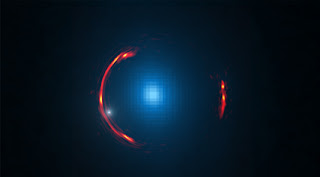Composite image of the gravitational lens SDP.81 showing the distorted ALMA image of the more distant galaxy (red arcs) and the Hubble optical image of the nearby lensing galaxy (blue center object). By analyzing the distortions in the ring, astronomers have determined that a dark dwarf galaxy (data indicated by white dot near left lower arc segment) is lurking nearly 4 billion light-years away. Credit: Y. Hezaveh, Stanford Univ.; ALMA (NRAO/ESO/NAOJ); NASA/ESA Hubble Space Telescope
Topics: Astronomy, Astrophysics, Dark Matter, Einstein, General Relativity, Gravitational Lensing, Radio Astronomy
Subtle distortions hidden in ALMA’s stunning image of the gravitational lens SDP.81 are telltale signs that a dwarf dark galaxy is lurking in the halo of a much larger galaxy nearly 4 billion light-years away. This discovery paves the way for ALMA to find many more such objects and could help astronomers address important questions on the nature of dark matter.
In 2014, as part of ALMA’s Long Baseline Campaign, astronomers studied a variety of astronomical objects to test the telescope's new, high-resolution capabilities. One of these experimental images was that of an Einstein ring, which was produced by the gravity of a massive foreground galaxy bending the light emitted by another galaxy nearly 12 billion light-years away.
This phenomenon, called gravitational lensing, was predicted by Einstein’s general theory of relativity and it offers a powerful tool for studying galaxies that are otherwise too distant to observe. It also sheds light on the properties of the nearby lensing galaxy because of the way its gravity distorts and focuses light from more distant objects.
National Radio Astronomy Observatory:
Dwarf Dark Galaxy Hidden in ALMA Gravitational Lens Image

Comments